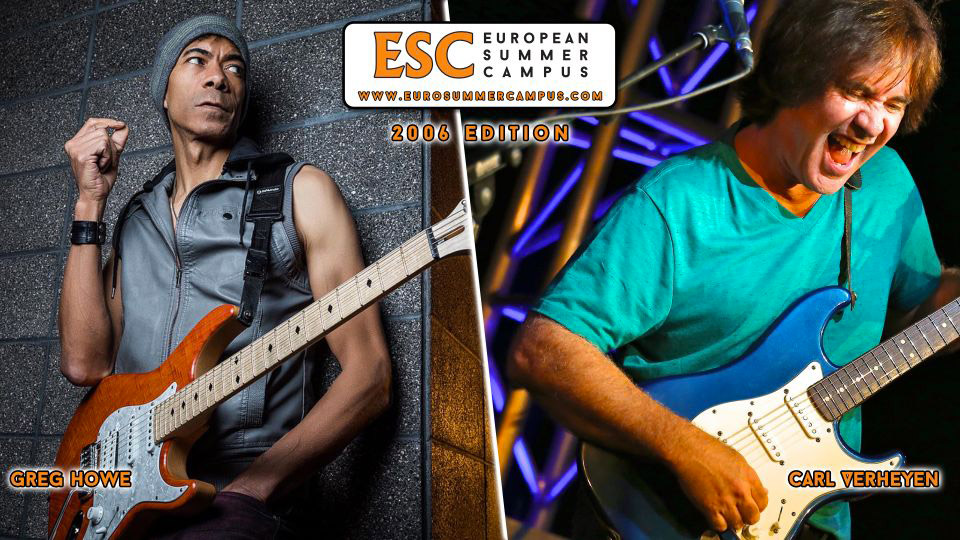The first edition of the ESC (European Summer Campus) took place in 2006 in Syracuse at the head office of the former MCAS (Mediterranean Center for Art and Science) in Via Roma, in the heart of Ortigia, now home of the Arcadia University.
For many years, MCAS has welcomed students from all over the world who have come to Sicily to learn about and study Sicilian culture and its many folkloristic and artistic facets.
Arcadia University, born later, has its head office in Pennsylvania (USA) and offers courses for the many US students who reside in Syracuse. Thanks to this important university, SCIE (Sicily Center for International Education) was born in 2015, offering all foreign students a series of special summer courses about Sicilian culture.
The artists of the first edition were Greg Howe and Carl Verheyen, while the double bass player and teacher Andrea Avena dealt with theoretical subjects.
Lessons were organised in ten-hour sessions in which the three musicians alternated, a real tour de force due to the Sicilian heat. The subjects were: technique, melodic approaches and improvisation, and also the musical instrumentation (gear) has been focused in a didactic manner. The guitarists talked about their own instruments, effects and amplifiers with customised settings. The guests naturally brought a light “travel” instrumentation, but their formidable sound, particular for each artist, comes from the hands and experience that the two guitarists have accumulated over the years. Just think that Greg Howe has collaborated with Michael Jackson, Ritchie Kotzen and Justin Timberlake; Carl Verheyen is an acclaimed session player, soundtrack composer, and boasts a career including Supertramp, The Bee Gees, Dolly Parton, and Stanley Clarke.
Andrea Avena gave lessons giving a general overview of theory and harmony, underlining the importance of Ear Training (educating the ear to recognise the intervals of a scale, using famous songs). He gave an excellent presentation on intervals, inversions, major scales, modes and triads.
He provided insights into II V I structure, turn arounds and harmonic resolutions, providing examples of Italian songs in which these are present.
Greg Howe gave lessons on technique. He started with an exemplary warm-up (for him) on his ESP custom: legatos, alternate picking, sweep, string skipping, tapping.
He expressed the importance of warming up before playing, showing some examples of arpeggios and patterns. Greg does not express himself in words, but it seems that the guitar speaks for him when the participants ask him many questions. He then clarified points on the barring technique, on fingerpicking simulato (hybrid pick-finger technique that leave you hypnotised).
He also talked about harmony, recommending which scales to play on a typical II V I jazz standard. He also focused on the typical “Hendrix chord”, aka E7#9, playing the pentatonic of Em and the diminished semitone/tone scale of E (pure versatility).
His improvisational approach is linked to a rhythmic vision, i.e. he is inspired by rhythmic cells carried on the fretboard in the form of phrasing, taking distances from trite clichés using arpeggios and chromatic notes.
The most human point reached during his class hours is certainly the invitation to a boy to play a blues, which has merged into an exciting jam.
His favourite sound is a “clean tone with an infinite sustain”.
Carl Verheyen, very communicative, gave lessons full of advice to better familiarise with the instrument (he brought a Stratocaster Daphne Blue), such as identifying a note on all octaves on the fretboard. He focused on the accompaniment, on the precision you need to have in every genre (especially for a session man like him), from funk to blues to jazz. Speaking of standards, he advises to study the melody first and only then the chords.
He revealed that he is passionate about rock legends such Eric Clapton, Jimi Hendrix and Jimmy Page by learning the phrasing directly from records; very old school. From this study emerges a very original execution of the major scales: not three notes per string, but a tight fingering with which to reach the close notes with slides and play above all wide intervals, creating the illusion of an arpeggio.
He also gave a lot of details on the instrumentation, such as getting getting good distortion and revealed that he often records multiple guitars to get a specific sound (he has a lot of guitars indeed, he hasn’t sold any!).
His sound is quite gloomy, zeroing out treble, giving room for middle and bass and pumping up resonance.
Participants received a first level certificate, allowing them to access the subsequent courses of the following editions.
At the end of the event, the first IGJ (International Guitar Jam) of the invited artists was held, which was also attended by Andrea Quartarone.
ARTISTS

